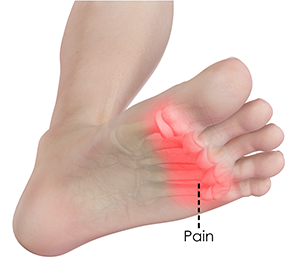Metatarsalgia Treatment

What is Metatarsalgia?
Metatarsalgia is a condition in which pain and inflammation on the ball of the foot is caused by an overuse or excess of pressure through the metatarsal heads. It is located at the area between the toes and the arch.
Causes of Metatarsalgia
Metatarsalgia can be caused by many factors, the most common including:
- Hypermobile 1st ray
- Intensive physical activity in sports from: tennis, ballet, golf, running etc.
- High-heeled footwear
- High-arched foot
- An unusually long metatarsal bone - usually of the second toe
- Toe deformities such as hammertoe
- Plantar plate tear
- Overlapping or underlapping toe
- Weak toe muscles
- A tight or short Achilles tendon
- Excess body weight
- Cycling with ill fitting shoes
- Running in minimalist shoes
Symptoms of Metatarsalgia
Symptoms of metatarsalgia include:
- Pain in the ball of the foot, which feels like a deep bruise and worsens when you stand or walk, especially when barefoot
- Feeling like you have a pebble at the base of your foot
- An area of hardened skin (callus) on the ball of the foot
- Swelling of the joints near the base of the toes (metatarsophalangeal joints)
Diagnosis of Metatarsalgia
Your doctor will discuss your symptoms and activities and perform a physical examination. Diagnostic tests that may be carried out include:
- X-rays: to identify any bone fractures
- Ultrasound: to evaluate soft tissue conditions such as bursitis or Morton’s neuroma
- MRI scan: to visualize the soft tissues surrounding the metatarsal bones
Treatment for Metatarsalgia
Metatarsalgia is normally treated by conservative methods that include:
- Applying ice over the area of pain
- Taking medications to reduce pain and inflammation
- Changing footwear
- Using pressure bandages on the foot
- Using a metatarsal pad
- Losing bodyweight
- Avoiding barefoot walking
When conservative methods are not found to be effective, surgery may be recommended for removing calluses, correcting deformities and realigning the metatarsal bones.
















